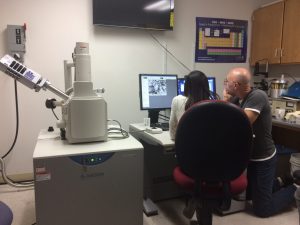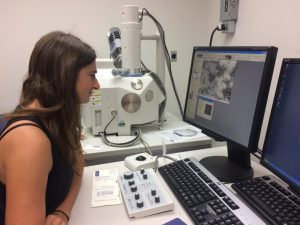SEM Theory
The following is a description of SEM history and function provided by Dr. Ivano Aiello, excerpted from Moss Landing Marine Laboratory's 50th anniversary blog. The full article can be accessed here, and we plan to add an even more thorough discussion in the near future.
To study the small world of the oceans, classic tools of marine science are not enough to observe and collect valid scientific data. The observation of the microscopic features of marine organisms such as corals, foraminifera, diatoms or sponges or the interior structures of organic cells (nucleus, mitochondria…etc.) requires very high magnifications, 10,000 and larger, more powerful than the optical microscopes, limited by the physics of light can yield.
The invention of the first electron microscope by Max Knoll and Ernst Ruska and the production of the earliest scanning-transmission electron microscope (SEM) by Manfred Von Ardenne in Berlin in the 1930s allowed scientists to finally observe the microscopic world to magnifications before unthinkable. The introduction of the first commercial scanning electron microscopes (SEMs) in 1965 opened up a new world of analysis for materials scientists.
Electron microscopes are scientific instruments that use a beam of energy electrons that allow us to ‘see’ objects on a very fine scale. The electrons are accelerated by a high voltage electron gun in a cathode ray tube (yes like the one used in the old school televisions) and condensed in a beam that scans and interacts with the specimen: the interactions produces new (secondary) electrons or backscattered (primary) electrons that are captured by a detector and turned into an electrical signal. A computer analyzes the signal and based on the location of the beam and intensity of the signal converts it into an image.
Moss Landing Marine Laboratories has been at the forefront of scanning electron microscopy to study of the ultrasmall world in marine science since the very beginning of this technology. In the early 1970s, the lab acquired a Topcon SEM. It was the work of MLML’s first faculty member Dr. James Nybakken who used the SEM to explore the world of marine invertebrates (James Nybakken: the first faculty member of MLML). Signe Amanda Lundstrum, a lab technician for Dr. Nybakken in the early 1970s, served as the first SEM technician until 1989 the year when the Loma Prieta 1989 earthquake destroyed the old building.




